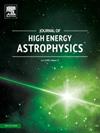Antisymmetric tensor influence on charged black hole lensing phenomena and time delay
IF 10.5
4区 物理与天体物理
Q1 ASTRONOMY & ASTROPHYSICS
引用次数: 0
Abstract
In this work, we investigate the gravitational lensing of a charged black hole (spherically symmetric) within the context of Lorentz violation triggered by an antisymmetric tensor field. Our calculations consider two different scenarios: the weak and strong deflection limits. For the weak deflection limit, we employ the Gauss–Bonnet theorem to obtain our results. In the strong deflection limit, we utilize the Tsukamoto methodology, which provides measurable outcomes such as relativistic image positions and magnifications. Applying the latter methodology, we analyze the gravitational lensing by Sagittarius and derive the related observables, which are expressed as functions of the Lorentz violation parameter. Finally, the time delay is addressed as well.
反对称张量对带电黑洞透镜现象和时间延迟的影响
在这项工作中,我们研究了在由反对称张量场触发的洛伦兹破坏的背景下带电黑洞(球对称)的引力透镜。我们的计算考虑了两种不同的情况:弱和强挠度极限。对于弱挠度极限,我们采用高斯-博内定理来得到结果。在强偏转限制下,我们使用冢本方法,它提供了可测量的结果,如相对论图像位置和放大倍率。应用后一种方法,我们分析了人马座A的引力透镜现象,并推导了相关的观测值,这些观测值被表示为洛伦兹违背参数的函数。最后,还解决了时间延迟问题。
本文章由计算机程序翻译,如有差异,请以英文原文为准。
求助全文
约1分钟内获得全文
求助全文
来源期刊

Journal of High Energy Astrophysics
Earth and Planetary Sciences-Space and Planetary Science
CiteScore
9.70
自引率
5.30%
发文量
38
审稿时长
65 days
期刊介绍:
The journal welcomes manuscripts on theoretical models, simulations, and observations of highly energetic astrophysical objects both in our Galaxy and beyond. Among those, black holes at all scales, neutron stars, pulsars and their nebula, binaries, novae and supernovae, their remnants, active galaxies, and clusters are just a few examples. The journal will consider research across the whole electromagnetic spectrum, as well as research using various messengers, such as gravitational waves or neutrinos. Effects of high-energy phenomena on cosmology and star-formation, results from dedicated surveys expanding the knowledge of extreme environments, and astrophysical implications of dark matter are also welcomed topics.
 求助内容:
求助内容: 应助结果提醒方式:
应助结果提醒方式:


